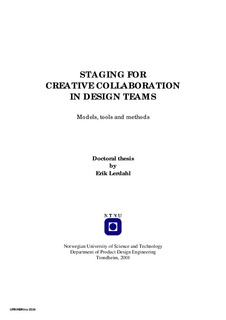| dc.description.abstract | Many design projects in industry require close collaboration between different actors in companies. Furthermore, due to globalisation and increased competition, companies have a growing need to quickly develop new innovative concepts and products. In this respect it is important to study how creative collaboration in design teams in the early phases of the design process may be stimulated and improved. The main objective of this thesis has been to develop models, tools and methods that stimulate and improve such collaboration. Factors involved in the staging for creative collaboration has been studied, and models, tools and methods have been developed. The empirical material was collected through in-depth interviews of company employees and design consultants. Furthermore, material was collected through action research in a new innovation course at NTNU in Trondheim and in 3 industrial cases.
Initially, three conceptual models are proposed and used as a background in the thesis.These models are visualised graphically. The first model proposes that the creative process is an ongoing cycle moving through order and chaos. The second model proposes that design is a creative activity in a dialectic tension. The third model, which is called the vision-based model, proposes that any product may be related to four levels of abstraction: the spiritual, the contextual, the principal and the material levels. All three models can function as tools for discussion and shared understanding in a team. In the innovation course the vision-based model functioned as a supporting tool for creative collaboration in the concept development process.
Further, the physical arrangement of space for creative collaboration in design teams has been studied. Two major concepts are proposed: Flexible project space and activity zones. The concept of activity zones, where different zones in the workspace are connected to different activities and modes of thinking, has been implemented in a specific case. The general conclusion is that conscious arrangement of space is one of the factors that may improve creative collaboration.
Results from the interviews show the need for a shared innovation level and focus in design team for good collaboration. It is concluded that participants in a team have different roles and perspectives and in this regard the concept of flexible role structure and the use of role-play are proposed for improving collaboration. The use of scenario play and mental visualisation exercises as tools in the concept development process have also been studied and tried out in courses and in specific industrial cases. The conclusion is that such exercises have both process and problem related effects and can help to improve creative collaboration in design teams.
Based on indicated limitations in existing methodology this thesis proposes finally, as the main contribution, a vision-oriented methodology for the early phases of the design process. It is divided into two stages: a vision-based and a specification-based stage. The vision-based stage has focus on user experience and applies visions, rather than specifications, as guidelines in the early phases of the concept development. Two types of visions are proposed in this stage: Goal visions and provocative visions. In the provocative visions elements of the goal visions are drawn to the extreme through fantasy scenarios. The methodology also integrates the physical arrangement of space and the use of scenario play, storytelling and mental visualisation exercises. It emphasises the extensive use of associative images and qualitative keywords. It also proposes the use of events, such as conceptual workshops and milestones, during the development process. Furthermore the methodology applies the vision-based model, with four levels of abstraction, as a supporting tool. Parts of the methodology (the vision-based stage) has been tried out and evaluated in the innovation course.
It is concluded that the methodology can help to improve creative collaboration in design teams, especially for projects that have a conceptual orientation and a focus on user experience. With an initial focus on visions it is argued that a design team may more easily create a shared understanding. Furthermore, with the active integration of
play and work with visions the methodology seems to be more process oriented, motivating and engaging than traditional methodology. It also integrates the active use of the body and senses and helps to avoid initial mental fixation to existing solutions. It is emphasised that it is important that the methodology is adapted to the specific company setting. | nb_NO |
